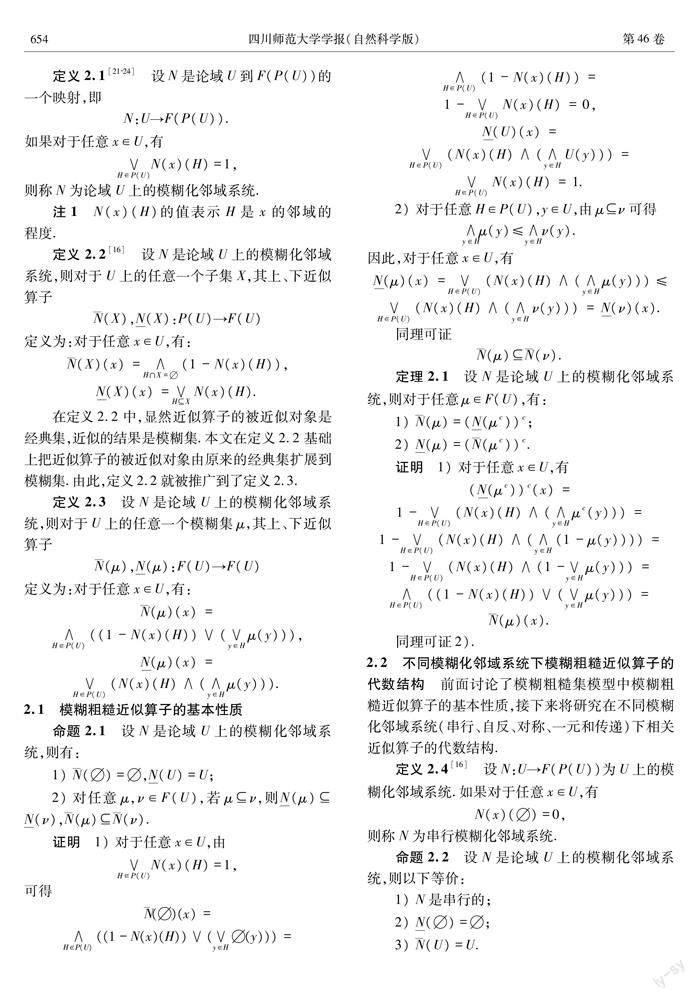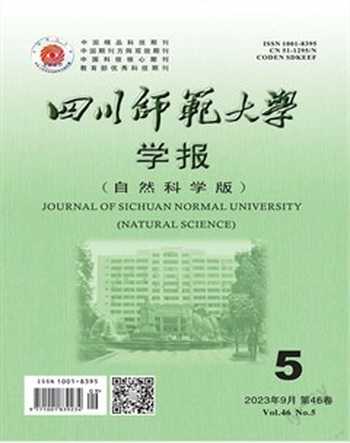基于模糊化鄰域系統的模糊粗糙集模型
候婷 冉虹 馬歡 秦克云



摘要:基于鄰域系統的粗糙集模型是Pawlak粗糙集模型的重要推廣形式.討論基于模糊化鄰域系統的模糊粗糙集模型,給出模型中模糊粗糙近似算子的構造方法并討論算子的基本性質.另外,當模糊化鄰域系統串行、自反、對稱、一元和傳遞時刻畫了相關近似算子的代數結構.
關鍵詞:模糊化鄰域系統; 上近似算子; 下近似算子; 粗糙集; 模糊集
中圖分類號:TP182 文獻標志碼:A 章編號:1001-8395(2023)05-0652-08
粗糙集理論是由波蘭數學家Pawlak[1]在1982年提出的,它是一種處理不確定性問題的重要數學工具.經過40多年的發展,粗糙集理論已經在機器學習[2]、決策分析[3]、模式識別[4]與數據挖掘[5]等領域被廣泛應用.
經典粗糙集模型是基于一個等價關系來建立近似空間.在現實生活中,基于等價關系的粗糙集模型在其它領域的應用具有一定的局限性.因此,眾多學者對經典的粗糙集模型進行擴展.用一般二元關系代替等價關系,Yao[6]提出了基于一般二元關系的廣義粗糙集模型.將等價關系弱化為相似關系[7]、容差關系[8]、優勢關系[9]等,等價關系確定的劃分就擴展成了論域的覆蓋.于是,經典粗糙集模型拓展到了覆蓋廣義粗糙集模型[10-11].
Lin[12]借助拓撲學中內點和閉包的概念,提出了基于鄰域系統的粗糙集模型.基于一般二元關系的粗糙集模型、基于覆蓋的粗糙集模型以及模糊粗糙集模型都是基于鄰域系統的粗糙集模型的特例[13].因此,研究基于鄰域系統的粗糙集模型具有重要的理論意義.另外,鄰域系統在群決策問題研究中具有直接的應用.Zhu等[14]建立了基于模糊鄰域系統的決策評價模型,將相應的評價問題表示為模糊鄰域信息系統,并討論了系統的屬性約簡問題.Zhang等[15]系統研究了基于鄰域系統的粗糙集模型中近似算子的相關性質.而模糊化鄰域系統是鄰域系統的一種推廣形式,它把鄰域從經典集擴展到模糊集.Li等[16]研究了經典集在模糊化鄰域系統下近似集的基本性質,以及當模糊化鄰域系統自反、串行和對稱等時討論了相關近似算子的性質.
文獻[16]中定義的近似算子的被近似對象是經典集,近似的結果是模糊集.本文是在文獻[16]的基礎上把近似算子的被近似對象從經典集推廣到模糊集,給出了模糊粗糙近似算子的定義,導出了基于模糊化鄰域系統的模糊粗糙集模型.本文主要研究模糊集在模糊化鄰域系統下模糊粗糙近似集的基本性質.此外,當模糊化鄰域系統自反、對稱和傳遞等時,文中進一步刻畫了模糊粗糙近似算子的代數結構.
1 預備知識
1.1 粗糙集
1.2 模糊集
1.3 基于鄰域系統的粗糙集
2 基于模糊化鄰域系統的模糊粗糙集模型
下面是在Li等[16]提出的基于模糊化鄰域系統的粗糙集模型的基礎上,給出了模糊粗糙近似算子的定義,導出基于模糊化鄰域系統的模糊粗糙集模型.本節主要研究模糊粗糙近似算子的基本性質,以及討論模糊化鄰域系統在串行、自反、對稱、一元和傳遞時模糊粗糙近似算子的代數結構.
參考文獻
[1] PAWLAK Z. Rough sets[J]. International Journal of Computer & Information Sciences,1982,11(5):341-356.
[2] AVISO K B, JANAIRO J I B, PROMENTILLA M A B, et al. Prediction of CO2 storage site integrity with rough set-based machine learning[J]. Clean Technologies and Environmental Policy,2019,21(8):1655-1664.
[3] DAI J H, LIU Z B, HU H, et al. Rough set model for cognitive expectation embedded interval-valued decision systems[J]. Chinese Journal of Electronics,2018,27(4):675-679.
[4] LIANG J Y, WANG F, DANG C Y, et al. An efficient rough feature selection algorithm with a multi-granulation view[J]. International Journal of Approximate Reasoning,2012,53(6):912-926.
[5] ZHANG J B, LI T R, CHEN H M. Composite rough sets for dynamic data mining[J]. Information Sciences,2014,257:81-100.
[6] YAO Y Y. Constructive and algebraic methods of the theory of rough sets[J]. Information Sciences,1998,109(1/2/3/4):21-47.
[7] STEFANOWSKI J, TSOUKIAS A. Incomplete information tables and rough classification[J]. Computational Intelligence,2001,17(3):545-566.
[8] LEUNG Y. Maximal consistent block technique for rule acquisition in incomplete information systems[J]. Information Sciences,2003,153:85-106.
[9] GRECO S, MATARAZZO B, SLOWINSKI R. Rough sets theory for multicriteria decision analysis[J]. European Journal of Operational Research,2001,129(1):1-47.
[10] ZHU W. Topological approaches to covering rough sets[J]. Information Sciences,2007,177(6):1499-1508.
[11] ZHU W, WANG F Y. On three types of covering-based rough sets[J]. IEEE Transactions on Knowledge and Data Engineering,2007,19(8):1131-1143.
[12] LIN T Y. Granular Computing:Practices,Theories,and Future Directions[M]. New York:Springer,2012:1404-1420.
[13] ?SYAU Y R, LIN E B, LIAU C J. Neighborhood systems:rough set approximations and definability[J]. Fundamenta Informaticae,2018,159(4):429-450.
[14] ?ZHU P, XIE H Y, WEN Q Y. A unified view of consistent functions[J]. Soft Computing,2017,21(9):2189-2199.
[15] ZHANG Y L, LI C Q, LIN M L, et al. Relationships between generalized rough sets based on covering and reflexive neighborhood system[J]. Information Sciences,2015,319:56-67.
[16] LI L Q, JIN Q, YAO B X, et al. A rough set model based on fuzzifying neighborhood systems[J]. Soft Computing,2020,24(8):6085-6099.
[17] YAO Y Y. Two views of the theory of rough sets in finite universes[J]. International Journal of Approximate Reasoning,1996,15(4):291-317.
[18] ZADEH L A. Fuzzy sets[J]. Information and Control,1965,8(3):338-353.
[19] SYAU Y R, LIN E B. Neighborhood systems and covering approximation spaces[J]. Knowledge-Based Systems,2014,66:61-67.
[20] ZHAO F F, LI L Q. Axiomatization on generalized neighborhood system-based rough sets[J]. Soft Computing,2018,22(18):6099-6110.
[21] FANG J M, YUE Y L. K. Fans theorem in fuzzifying topology[J]. Information Sciences,2004,162(3/4):139-146.
[22] FANG J M, CHEN P W. One-to-one correspondence between fuzzifying topologies and fuzzy preorders[J]. Fuzzy Sets and Systems,2007,158(16):1814-1822.
[23] HERRLICH H, ZHANG D X. Categorical properties of probabilistic convergence spaces[J]. Applied Categorical Structures,1998,6(4):495-513.
[24] YING M S. A new approach for fuzzy topology (I)[J]. Fuzzy Sets and Systems,1991,39(3):303-321.
Fuzzy Rough Set Model Based on Fuzzifying Neighborhood Systems
HOU Ting RAN Hong MA Huan QIN Keyun
(School of Mathematics, Southwest Jiaotong University, Chengdu 611756, Sichuan)
Abstract:The generalized rough set in neighborhood system is an important extension of the Pawlaks rough set model. This paper discusses the fuzzy rough set model based on the fuzzifying neighborhood system. The construction method of the fuzzy rough approximation operators in the model is presented and the basic properties of the operators are investigated. In addition, when the fuzzifying neighborhood system is serial, reflexive, symmetric, unary and transitive, the algebraic structures of the related approximation operators are examined.
Keywords:fuzzifying neighborhood system; upper approximation operator; low approximation operator; rough set; fuzzy set
2020 MSC:47H99
(編輯 余毅)

